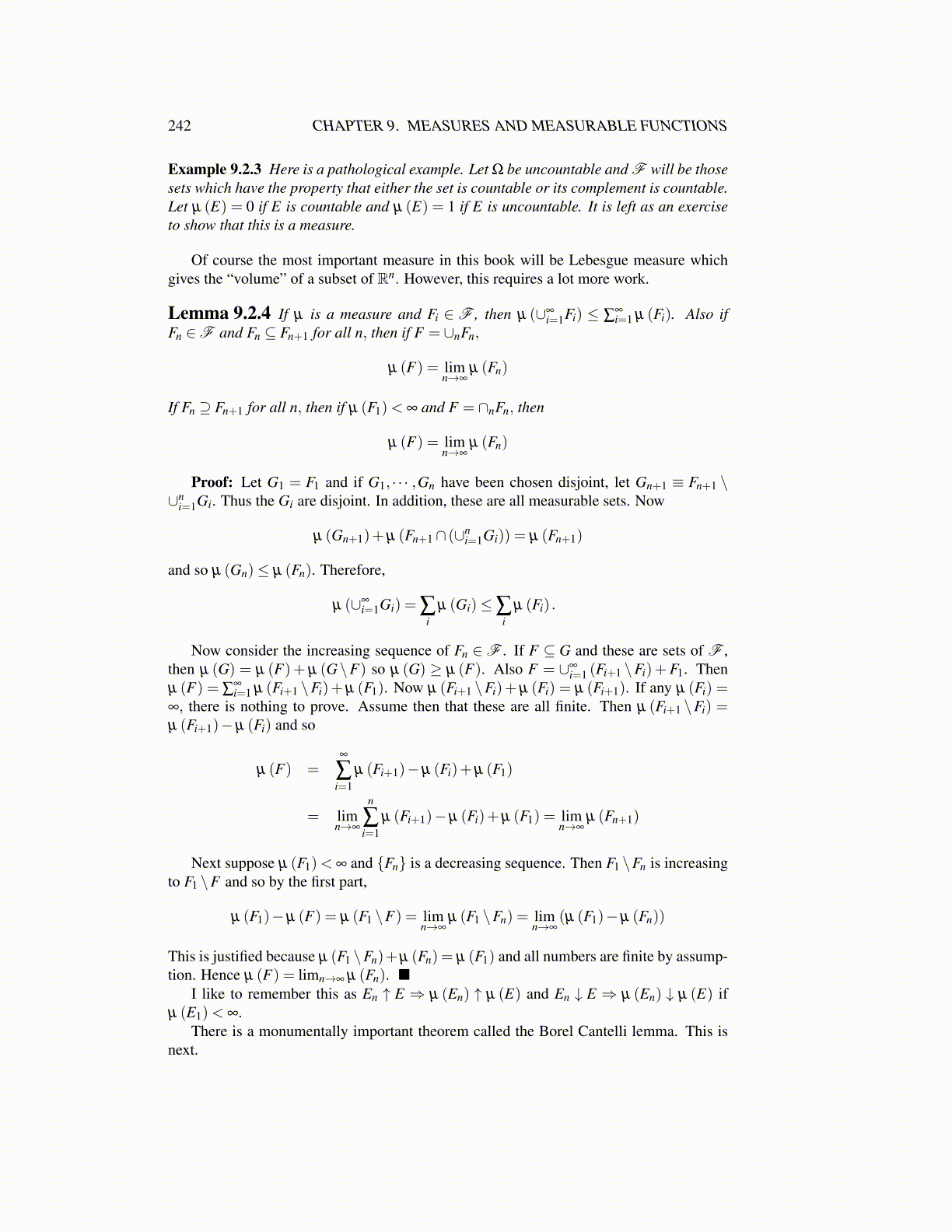
242 CHAPTER 9. MEASURES AND MEASURABLE FUNCTIONS
Example 9.2.3 Here is a pathological example. Let Ω be uncountable and F will be thosesets which have the property that either the set is countable or its complement is countable.Let µ (E) = 0 if E is countable and µ (E) = 1 if E is uncountable. It is left as an exerciseto show that this is a measure.
Of course the most important measure in this book will be Lebesgue measure whichgives the “volume” of a subset of Rn. However, this requires a lot more work.
Lemma 9.2.4 If µ is a measure and Fi ∈ F , then µ (∪∞i=1Fi) ≤ ∑
∞i=1 µ (Fi). Also if
Fn ∈F and Fn ⊆ Fn+1 for all n, then if F = ∪nFn,
µ (F) = limn→∞
µ (Fn)
If Fn ⊇ Fn+1 for all n, then if µ (F1)< ∞ and F = ∩nFn, then
µ (F) = limn→∞
µ (Fn)
Proof: Let G1 = F1 and if G1, · · · ,Gn have been chosen disjoint, let Gn+1 ≡ Fn+1 \∪n
i=1Gi. Thus the Gi are disjoint. In addition, these are all measurable sets. Now
µ (Gn+1)+µ (Fn+1∩ (∪ni=1Gi)) = µ (Fn+1)
and so µ (Gn)≤ µ (Fn). Therefore,
µ (∪∞i=1Gi) = ∑
iµ (Gi)≤∑
iµ (Fi) .
Now consider the increasing sequence of Fn ∈F . If F ⊆ G and these are sets of F ,then µ (G) = µ (F)+ µ (G\F) so µ (G) ≥ µ (F). Also F = ∪∞
i=1 (Fi+1 \Fi)+F1. Thenµ (F) = ∑
∞i=1 µ (Fi+1 \Fi)+µ (F1). Now µ (Fi+1 \Fi)+µ (Fi) = µ (Fi+1). If any µ (Fi) =
∞, there is nothing to prove. Assume then that these are all finite. Then µ (Fi+1 \Fi) =µ (Fi+1)−µ (Fi) and so
µ (F) =∞
∑i=1
µ (Fi+1)−µ (Fi)+µ (F1)
= limn→∞
n
∑i=1
µ (Fi+1)−µ (Fi)+µ (F1) = limn→∞
µ (Fn+1)
Next suppose µ (F1)< ∞ and {Fn} is a decreasing sequence. Then F1 \Fn is increasingto F1 \F and so by the first part,
µ (F1)−µ (F) = µ (F1 \F) = limn→∞
µ (F1 \Fn) = limn→∞
(µ (F1)−µ (Fn))
This is justified because µ (F1 \Fn)+µ (Fn) = µ (F1) and all numbers are finite by assump-tion. Hence µ (F) = limn→∞ µ (Fn). ■
I like to remember this as En ↑ E ⇒ µ (En) ↑ µ (E) and En ↓ E ⇒ µ (En) ↓ µ (E) ifµ (E1)< ∞.
There is a monumentally important theorem called the Borel Cantelli lemma. This isnext.